
Shelby is a city in and the county seat of Cleveland County, North Carolina. It lies near the western edge of the Charlotte-Concord, NC-SC Combined Statistical Area. The population was 21,918 at the 2020 census.
S. H. Kress & Co. was the trading name of a chain of five and dime retail department stores in the United States established by Samuel Henry Kress. It operated from 1896 to 1981. In the first half of the 20th century, there were Kress stores with ornamented architecture in hundreds of cities and towns.

Harris Teeter Supermarkets, LLC., also known as Harris Teeter Neighborhood Food & Pharmacy, is an American supermarket chain based in Matthews, North Carolina, a suburb of Charlotte. As of February 2024, the chain operates 259 stores in seven South Atlantic states and Washington, D.C. Supermarket News ranked Harris Teeter No. 34 in the 2012 "Top 75 Retailers & Wholesalers" based on 2011 fiscal year sales of $4.3 billion.

SouthPark is an upscale shopping mall in the affluent SouthPark neighborhood in Charlotte, North Carolina. The mall is located approximately five miles (8 km) south of Uptown Charlotte, at the corner of Sharon and Fairview Roads. With 1,688,480 square feet (160,000 m2), It is one of the most profitable malls in the country with sales at over $700 per square foot. It is the 10th largest on the East Coast and is the 28th largest in the United States. SouthPark is the most congested shopping area in the United States during Black Friday weekend. The mall is visited by more than 12 million visitors a year.
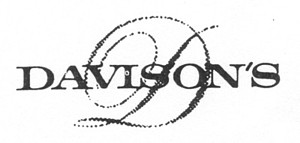
Davison's of Atlanta was a department store chain and an Atlanta shopping institution. It was the major competition to Rich's and it took the Macy's name in 1986.
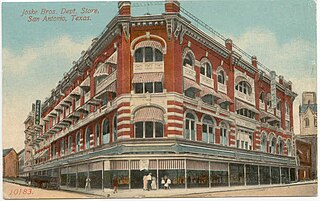
Joske's, founded by German immigrant Julius Joske in 1867, was a department store chain originally based in San Antonio, Texas. In December 1928, Hahn Department Stores acquired the company along with the Titche-Goettinger department store of Dallas, and three years later Hahn became part of Allied Stores. Allied was taken over by Campeau in 1986, and Campeau in turn sold the Joske's chain in 1987 to Dillard's. All Joske's stores were then quickly converted into Dillard's locations.

The Peabody Memphis is a historic luxury hotel in Downtown Memphis, Tennessee, opened in 1925. The hotel is known for the "Peabody Ducks" that live on the hotel rooftop and make daily treks to the lobby. The Peabody is a member of Historic Hotels of America, a program of the National Trust for Historic Preservation.
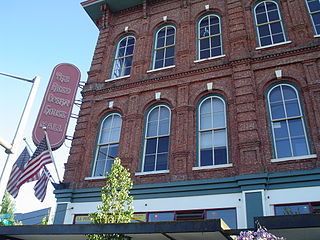
The Reed Opera House and McCornack Block Addition, more commonly known as The Reed Opera House or The Reed, is a historic building in downtown Salem, Oregon, United States. Since its grand opening on September 27, 1870, the Reed Opera House has served as a performing arts center and shopping mall. The Italianate brick structure was added to the National Register of Historic Places in 1978.

The May Company Ohio was a chain of department stores that was based in Cleveland, Ohio, United States.

The Hamilton Building also known as The Flatiron Building of Bellingham and the Bellingham Bay Furniture Building was the first "skyscraper" in Bellingham. Built in 1908 for Talifero Simpson Hamilton's growing Bellingham Bay (B.B.) Furniture Company established in 1889, the building cost $100,000 and used thirty-five thousand barrels of cement along with 200,000 pounds of steel. Due to its triangular shape and resemblance to the Fuller Building in New York, the building instantly garnered the flatiron nickname. It was Bellingham's tallest structure until 1926.
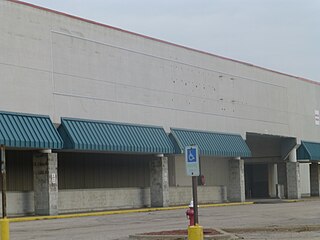
Twin Valu was a U.S. hypermarket and was one of the first hypermarkets in the Akron, Ohio, area. The original Twin Valu store was located on Howe Avenue in Cuyahoga Falls, Ohio. The $10 million, 180,000-square-foot (17,000 m2) store was open 24 hours a day, 7 days a week. It boasted 52 checkout lanes, a full bakery, deli, meat department, smokehouse, food court, floral department, jewelry department, electronics department, photo department, vision center, and pharmacy in addition to groceries, clothing, housewares, and general merchandise. A Star Bank branch location was added later.

Montgomery Park is an office building and former Montgomery Ward mail-order catalog warehouse and department store located in Portland, Oregon, United States, built in 1920. It is listed on the National Register of Historic Places under its historic name Montgomery Ward & Company Building. The building is located on property once used for the Lewis and Clark Centennial Exposition, of 1905. It was occupied by Montgomery Ward from 1920 until 1985, although the majority of the company's operations at this location ended in 1982. The building is the third-largest office building in Portland with 756,055 square feet (70,239.8 m2).
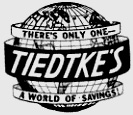
Tiedtke's was a former grocery and department store chain based in Toledo, Ohio. At its peak, the store, which began life as a grocery, occupied a huge building at Summit Street and Adams downtown, maintained an annex store two blocks away, and a branch store in north Toledo. It was a unique Toledo experience, and a community center. The family-founded store changed hands several times before all locations closed by 1973. The original store building was destroyed by fire two years later.

Efird's Department Store, also known as Lourie's Department Store, is a historic department store building located at Columbia, South Carolina. It was built about 1870, and is a rectangular brick building renovated and expanded in 1919. This included the addition of a third story and the installation of a new brick façade and store entrances. Between 1919 and 1958, it housed the Columbia branch of the Charlotte, North Carolina based Efird's Department Store chain. It currently houses a Mast General Store, which moved in on May 25, 2011.
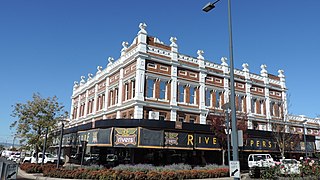
Barnes and Co. Trading Place is a heritage-listed former department store at 118 Palmerin Street, Warwick, Southern Downs Region, Queensland, Australia. It was designed by Wallace & Gibson and built from 1910 to 1911 by M Ivory. It is also known as Smith & Miller Furniture Store. It was added to the Queensland Heritage Register on 21 October 1992.
Shoppers' City was a chain of seven stores in the Minneapolis / St. Paul area in the 1960s and 1970s. It was one of the forerunners of the "big box" store. The chain was notable for being one of the first stores in Minnesota to open on Sundays. It included discount groceries, home goods and sundries along with a barber shop, pharmacy, dry cleaners and snack bar; it also featured a furniture and appliance department on the mezzanine, at one time run by the Furniture Barn. In the early 1970s the furniture departments were owned by Harold Sklar & his son, Charles. They also owned Sklar's Furniture Store in Duluth's West End in the mid-1970s, where it was surrounded by 4 other furniture stores. It was sold to the larger Massachusetts-based chain Zayre in 1967 and the Zayre locations in the Twin Cities market were thereafter known as "Zayre Shoppers' City."

The Braastad–Gossard Building, also known as the Gossard Building or Pioneer Square, is a commercial building located at 308 Cleveland Avenue in Ishpeming, Michigan. It was listed on the National Register of Historic Places in 2015.

The Halle Building, formerly known as the Pope Building and after 2014 as The Residences at Halle, is an 11-story Chicago School mixed-use structure located in the Downtown Cleveland central business district in Cleveland, Ohio, in the United States. Designed by architect Henry Bacon, the building was the flagship department store of the Halle Brothers Co. from 1910 to 1982.

Boadway Bros. or Boadway's was a chain of upscale department stores in Southern California and New Mexico during the 1910s and 1920s, which started with a single store in Pasadena carrying furniture.




















